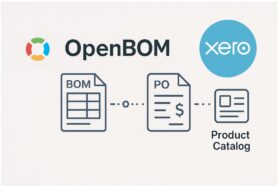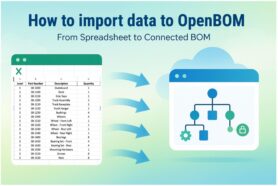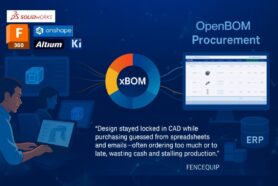
In today’s blog post we’ll be finishing up a 5 part series about OpebBOM’s data management best practices. If you missed the first 4 installments of this series, please check them out here: Part 1, Part 2, Part 3, and Part 4.
In the previous blog posts, I covered basic principles of OpenBOM data management foundation, shared methodology of data management, and how to escape from Excel or other spreadsheets, as well as provided you with guidance on data elements – properties, catalogs, BOMs, and views.
This is the final article and I’m going to talk about typical mistakes and misconceptions that we can see users make when approaching OpenBOM data management. Keep in mind that these mistakes are not happening because we’ve got it wrong and not because users don’t learn it well enough. From our experience, the challenge is to switch your mind and think differently about the data. And this is what we want to help you with.
Misconception 1: OpenBOM manages BOMs like Excels
One of the most typical mistakes is to think that OpenBOM is storage from your BOM spreadsheets, but… a little bit better. An attempt to add BOMs like files and manage them as spreadsheets containing data is wrong and you will be missing a key component of OpenBOM’s platform – which is a data management system managing Items, Product Structures. The data is located in your account and OpenBOM connects multiple pieces of the data by managing items, their data properties, relationships, instances, etc. Think database and stop thinking about files.
Misconception 2: BOM is a file and Catalog is a Folder
BOM is a file and you need to put them into catalogs, so you can use them again. Although in some cases you can think about a catalog as a container, it doesn’t include BOMs. In OpenBOM, the catalog is a container that includes items. So you should think about a catalog as a database of items. OpenBOM allows you to have as many catalogs as you need and they are all can be used together.
Misconception 3: Catalog Includes BOMs
This one is the outcome of thinking about catalogs as folders including BOM (excels files). This is wrong because OpenBOM is a database management system managing items in catalogs. Bill of Materials (product structure) are using items from catalogs and by doing so, you can create an instance of items that reference all properties items from the catalog and add instance properties (eg. Quantity, Reference Designator, Calculated Cost) on the BOM level.
Misconception 4: I need a catalog for each BOM
Another wrong assumption is that you need a catalog for each BOM or product you design. This is another outcome of “file” thinking. Catalog(s) are representing all item information in the company (think about Item Master concept). The right approach is to define a set of catalogs representing your data types (eg. Mechanical, Electrical, Assemblies, etc.), sometimes contractors and suppliers, and, very rarely, a specific project.
Misconception 5: Views are like a template for data
Another mistake is to think that a view defines the data properties and you can add it to the catalog, BOM, etc. to define the data. This is wrong. A view is a kind of lens that allows you to manage a proper data visualization (in this case to define a visible list of properties and filters). Views are useful to define what data is visible in the grid (for single users) and who can access specific data levels (views) for team and company subscriptions.
Video – OpenBOM Data Management How to Start?
In the following video, I will give you a live demo of how to start managing data in OpenBOM – (1) create a catalog; (2) define properties; (3) add items, (4) create views; (5) create a BOM. Use it as quick start guide. It doesn’t cover all features and functions but will give you an idea of how to start.
Conclusion
We worked hard to make OpenBOM similar to Excel from the simplicity and ease of use. But as much as OpenBOM looks, feels and smells “Excel”, it is not. So, please take time and understand the OpenBOM data management concept to take advantage of it for your work.
If you haven’t done so already REGISTER FOR FREE to learn what OpenBOM can do for you.
Best, Oleg
Join our newsletter to receive a weekly portion of news, articles, and tips about OpenBOM and our community.









